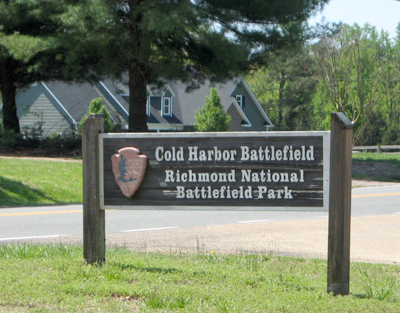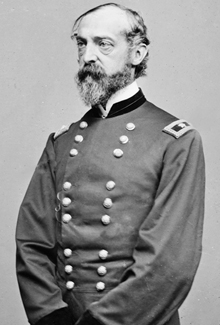Cold Harbor • Tour the Battlefield • Monuments & Markers • The Armies
The Battle of Cold Harbor in June of 1864 was Robert E. Lee’s last great victory of the Civil War. Outnumbered almost two to one, his entrenched veterans caused massive losses in Grant’s army. Many of Grant’s troops were new recruits or rear area troops facing their first battle, which contributed to the disaster.
About 95% of the Cold Harbor battlefield has been lost to development. A 300 acre tract is preserved by the National Park Service as part of the Richmond Battlefield National Park. A nearby 50 acre tract is preserved by Hanover County. Garthright House, used as a field hospital during the battle, has also been saved by the National Park Service. A small National Cemetery is adjacent to the battlefield park.
Although small, the battlefield contains a number of well-preserved entrenchments. The National Park Visitor Center provides background information about the battles fought there, including the 1862 Battle of Gaines’ Mill that occured over roughly the same area.

Explore the Battle of Cold Harbor
Tour the Battlefield
The National Park has a short auto tour as well as walking trails. The county park also has a walking trail with interpretive markers.
View the monuments and historical markers
Each has a photo, a transcription of its text, and a map location with directions.
The Armies at Cold Harbor
The Orders of Battle for the Army of the Potomac and the Army of Northern Virginia show the organization of the troops of both sides during the battle. Links lead to more in-depth information about the individuals, regiment and batteries on a companion website, wwws.civilwarintheeast.com.

Who fought in the Battle of Cold Harbor?
The Battle of Cold Harbor was fought between the Federal Army of the Potomac under Major General George Meade and directly supervised by Lieutenant General Ulysses S. Grant, commander of all Union forces, and the Confederate Army of Northern Virginia under General Robert E. Lee.
Grant was reinforced by Major General William F. Smith’s corps from Major General Benjamin Butler’s Army of the James. Lee was reinforced by Major General Robert F. Hoke’s Division from General P.G.T. Beuregard’s forces south of the James River and Major General John C. Breckenridge’s division from the Shenandoah Valley.
 General Robert E. Lee |
 Major General George Gordon Meade |
 Lieutenant General Ulysses S. Grant |
When was the Battle of Cold Harbor fought?
The Battle of Cold Harbor lasted from May 31 until June 12, 1864. The most intense fighting, Grant”s Grand Assault, was on June 3.
Where was the Battle of Cold Harbor fought?
The Battle of Cold Harbor was fought about ten miles northeast of Richmond, Virginia, in what is now the city of Mechanicsville. Cold Harbor was not a port or even on the water. The name comes from the term for a tavern where you could sleep (harbor) but that did not serve hot meals.
How many men fought in the Battle of Cold Harbor?
Grant commanded about 108,000 men. Lee had about 59,000. While Lee’s army was composed almost entirely of experienced veterans, many Union troops were new conscripts or artillerymen who had spent the war behind the lines in the Washington defences and who now fought as infantry.
How many casualties were there in the Battle of Cold Harbor? How many men died there?
There are no exact numbers available and estimates vary for the number of casualties at the Battle of Cold Habor. Union casualties are estimated at between 12,000 and 15,000, with Confederate casualties between 1,500 and 5,000. It was one of the most lopsided casualty rates in the war.
Who won the Battle of Cold Harbor?
The Battle of Cold Harbor was a clear Confederate victory. It was Lee’s last great victory of the Civil War.
Why was the Battle of Cold Harbor important?
Lee had prevented Grant from breaking through the Confederate lines to capture Richmond, less than 10 miles away. He had caused Grant so many casualties that anti-war sentiment in the north became a serious issue for the Lincoln administration. The battle forced Grant to once more disengage and find another way around Confederate entrenchments – which he did by moving his army to Petersburg.
